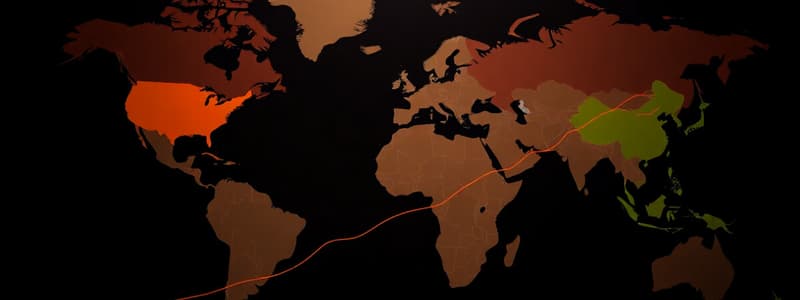Podcast
Questions and Answers
What does the term 'factor intensity' refer to?
What does the term 'factor intensity' refer to?
- The ratio of capital to labor used in the production of a good (correct)
- The measurement of how much labor influences production
- The ratio of technology to labor used in production
- The total output produced by a unit of input
The opportunity cost of Good A is calculated as the Gain in Good A divided by the Loss of Good B.
The opportunity cost of Good A is calculated as the Gain in Good A divided by the Loss of Good B.
False (B)
What is the key difference between absolute and comparative advantage?
What is the key difference between absolute and comparative advantage?
Absolute advantage refers to the ability of a country to produce more of a good with the same resources compared to another country, while comparative advantage refers to the ability to produce a good at a lower opportunity cost.
The opportunity cost of Good A is calculated using the formula: Opportunity Cost of Good A = Loss of Good B / _________.
The opportunity cost of Good A is calculated using the formula: Opportunity Cost of Good A = Loss of Good B / _________.
Match the following theories or concepts with their descriptions:
Match the following theories or concepts with their descriptions:
What economic theory focuses on specialization based on relative cost differences?
What economic theory focuses on specialization based on relative cost differences?
A country with an absolute advantage should not engage in trade.
A country with an absolute advantage should not engage in trade.
What does the term 'opportunity cost' refer to in the context of international trade?
What does the term 'opportunity cost' refer to in the context of international trade?
The __________ shows all possible combinations of two goods that a country can efficiently produce with its resources.
The __________ shows all possible combinations of two goods that a country can efficiently produce with its resources.
Which of the following best describes Adam Smith's Theory?
Which of the following best describes Adam Smith's Theory?
Under the Heckscher-Ohlin Model, countries export goods that utilize their scarce factors of production.
Under the Heckscher-Ohlin Model, countries export goods that utilize their scarce factors of production.
When two countries specialize based on their comparative advantages, they can achieve __________ from trade.
When two countries specialize based on their comparative advantages, they can achieve __________ from trade.
Match the economic theories with their main concepts:
Match the economic theories with their main concepts:
Flashcards
Factor Intensity
Factor Intensity
The ratio of capital to labor used in the production of a good.
Opportunity Cost of Good A
Opportunity Cost of Good A
The loss of Good B divided by the gain in Good A.
Comparative Advantage
Comparative Advantage
Comparing opportunity costs between countries for producing goods.
Classical Trade Theory Assumptions
Classical Trade Theory Assumptions
Signup and view all the flashcards
Absolute Advantage
Absolute Advantage
Signup and view all the flashcards
Opportunity Cost
Opportunity Cost
Signup and view all the flashcards
Production Possibility Frontier (PPF)
Production Possibility Frontier (PPF)
Signup and view all the flashcards
Heckscher-Ohlin (H-O) Model
Heckscher-Ohlin (H-O) Model
Signup and view all the flashcards
Relative Factor Endowment
Relative Factor Endowment
Signup and view all the flashcards
Gains from Trade
Gains from Trade
Signup and view all the flashcards
International Trade
International Trade
Signup and view all the flashcards
Study Notes
Introduction to International Trade
- International trade enables countries to consume goods/services they can't efficiently produce internally.
- Key benefits include specialization based on comparative advantage, increased efficiency from competition & economies of scale, and broader access to goods.
Absolute and Comparative Advantages
- Absolute Advantage (Smith): A country possesses absolute advantage if it produces a good using fewer resources compared to another country.
- Specialization in goods where a country is absolutely more efficient is logical.
- Comparative Advantage (Ricardo): Trade is driven by relative cost differences (opportunity costs) rather than absolute advantages.
- A country holds comparative advantage in producing a good if the opportunity cost of producing it is lower than another country's.
Opportunity Costs and Gains from Trade
- Opportunity Cost: The amount of one good that must be given up to produce one unit of another good.
- Calculated as (loss of good B) / (gain in good A).
- Trade leads to gains when countries specialize in goods with comparative advantage and exchange those goods.
Production Possibility Frontier (PPF)
- PPF: Depicts all possible combinations of two goods that a country can efficiently produce.
- Constant Average Costs: A straight-line PPF; opportunity costs remain consistent.
- Increasing Average Costs: A concave curve PPF; opportunity costs rise with greater specialization.
Heckscher-Ohlin (H-O) Model
- H-O Theory: Extends Ricardo's model by considering factor endowments (like labor or capital).
- Countries export goods requiring their abundant factors and import goods requiring their scarce factors.
- Relative Factor Endowment: Capital-to-labor ratio within a country.
- Factor Intensity: Capital-to-labor ratio in the production of a good.
Formulas and Calculations
- Opportunity Cost Calculation: Opportunity Cost of A = (Loss of B) / (Gain of A).
- Comparative Advantage Determination: By comparing opportunity costs for each good in different countries.
Key Assumptions of Classical Trade Theory
- Two countries, two goods.
- Fixed resources & technology.
- No transportation costs or trade barriers.
- Full (Ricardo) or partial specialization (H-O).
Quiz Preparation
- Differentiate between absolute vs. comparative advantage.
- Calculate opportunity costs with examples.
- Describe the PPF shape under constant average costs and reasoning.
- Explain the Heckscher-Ohlin Model's implication on international trade.
- State the key assumptions of Ricardo's theory.
Studying That Suits You
Use AI to generate personalized quizzes and flashcards to suit your learning preferences.




